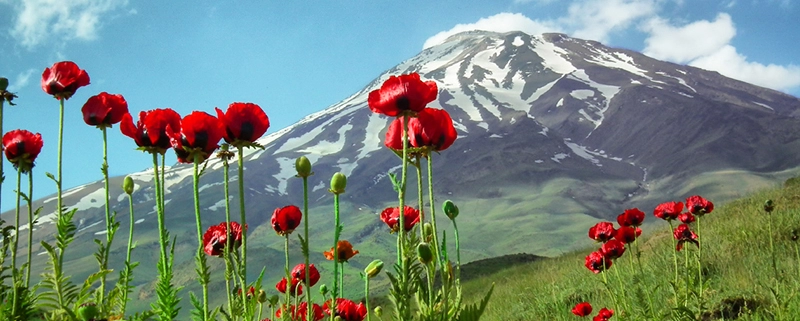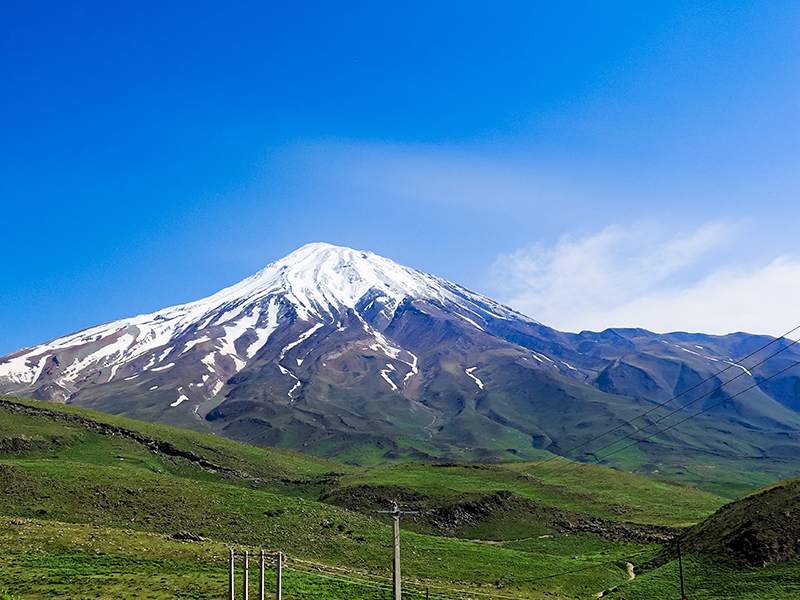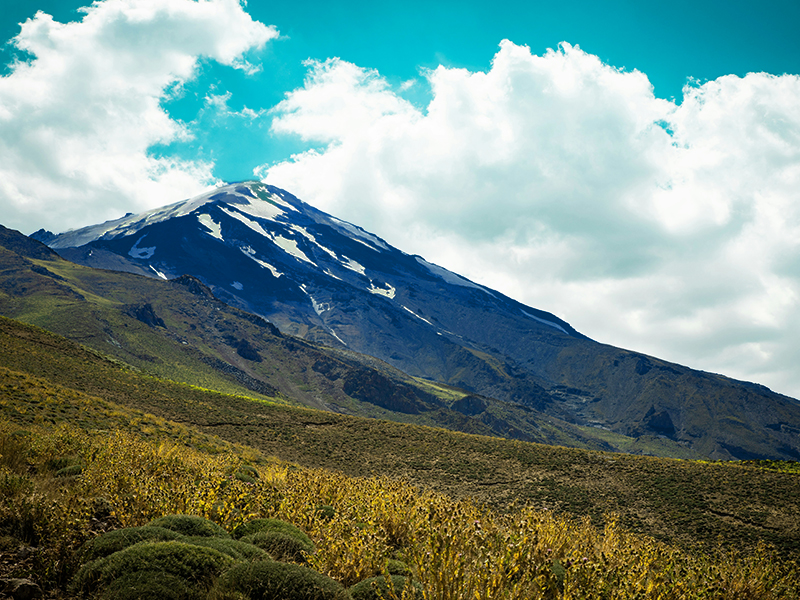Mt Damavand; Tallest Volcano in Asia: Weather, Height
As the highest volcano in Asia and the tallest peak in the Iranian and Middle Eastern mountain ranges, Mount Damavand stands proudly at a height of 5,000 meters. Its imposing stature contributes to the region’s unique climate, with temperatures reaching freezing in the summer and dropping to -60 degrees Celsius in the winter. Damavand, which was recognized as Iran’s first natural heritage in 1387 (2008) and was recognized as a national natural work since 1381 (2002), is a symbol of greatness and glory that is deeply embedded in the country’s literature and history. This article aims to introduce the magnificent beauty of Mount Damavand and discover its unique peak with a history of human habitation on its mountain slopes for about 38 centuries. Join us on this journey to explore the different aspects of this outstanding mountain.
What Is Special about Mount Damavand?
Mount Damavand has a special place in both the natural landscape and cultural heritage of Iran. Beyond the physical prominence, Damavand is a dormant volcano, which adds an interesting geological dimension to it. The mountain is also deeply rooted in Persian mythology, often associated with heroic tales and legends. Its snow-capped summit, visible from miles away, is a symbol of national pride and resilience.
Mount Damavand Weather
The weather in the Damavand region shows a wide range of temperatures, fluctuating from a minimum of -60 degrees Celsius to a maximum of 2 degrees Celsius, depending on the prevailing climate and season within this spectrum. Precipitation in this area usually takes the form of snow, with an average annual snowfall of 1400 millimeters. Wind speeds and storms on Mount Damavand can reach approximately 150 kilometers per hour, gradually decreasing to around 70 kilometers per hour at the foothills. The predominant wind direction is usually from the west to the northwest.
It is noteworthy that the air pressure in this region is half that of sea level, which contributes to the unique and challenging weather conditions that define the environment surrounding this iconic peak. The prevailing wind direction is usually from west to northwest. Remarkably, the air pressure in this area is half that of sea level, which contributes to the unique and challenging weather conditions that characterize the environment surrounding Damavand Peak (Mount Damavand weather)
Damavand Volcano
Damavand is a semi-active volcanic mountain that was formed during the Holocene geological era, specifically in the fourth period. Its estimated age, determined using carbon-14 dating, is at least 38,500 years. Evidence of its semi-active nature is found in several sulfur springs and hot water outlets. The primary volcanic activity that shaped the mountain occurred around 10,000 years ago.
The volcano has a crater diameter of approximately 400 meters, covered by a glacier-formed ice lake. While some dispute its volcanic classification and claim that Damavand is not a volcano, others argue that the presence of greenhouse gases and hot springs act as an indicator of its ongoing volcanic activity. This mountain is both a geological wonder and the subject of debate about its volcanic status.
Damavand Ski
Damavand offers an attractive skiing experience and draws enthusiasts to its snowy slopes. The magnificent peaks of this mountain provide an ideal environment for winter sports, with different routes that accept skiers of different skill levels. The thrill of skiing in Damavand is enhanced by its stunning mountain scenery and pristine snow-covered scenery. The skiing season usually continues in the winter months and provides plenty of opportunities for adventure seekers to enjoy the thrilling descent from the heights of Iran’s highest peak (Iran ski tour).
Mount Damavand Facts
Mount Damavand, a semi-dormant volcano, witnessed its first eruption about two million years ago, with its formation dating back to around thirty-eight thousand years ago! In 2013, the National Geographic magazine listed Damavand as the tenth among the world’s most dangerous mountains. Despite being a dormant volcano, the summit of Damavand is perennially snow-covered, experiencing severe cold with temperatures dropping to minus two degrees Celsius in the summer and a bone-chilling minus sixty degrees Celsius in the winter.
Damavand Mountain Hike
The tradition of Mount Damavand Climb dates back to ancient times, although historical records may not have recorded the footsteps of those who ventured to its summit. However, signs of human presence are evident in local stories, such as tales surrounding the sulfur well located at the peak of Damavand. Local reports describe a challenging climb, claiming it took five days and nights to reach the summit.
Damavand has an international reputation and attracts visitors from all over the world and has been the focus of attention of foreign travelers in Iran. In 1837, Europeans achieved the first documented ascent of Damavand, attributed to Tyler Thompson, while the first documented Iranian ascent dates back to 1857. The charm of Damavand is not only in its historical importance but also in its continuous attraction to domestic and international people.
Damavand Mountain Height
Different sources have reported different heights for Mount Damavand; however, according to the official portal of the National Organization of Geographical Names of Iran, the Damavand height is recorded as 5610 meters. Other sources, such as the databases of the Geological Survey of Iran and the NASA Earth Observatory website, have considered elevations of 5670 and 5671 meters, respectively. Regardless of minor changes in measurements, Damavand holds the twelfth place among the world’s tallest peaks in terms of height. The discrepancy in reported heights underscores the ongoing interest and scientific exploration surrounding this iconic mountain.
What Is the Ranking of Damavand Mountain?
Mount Damavand has the twelfth place among the world’s tallest peaks in terms of elevation. This magnificent stratovolcano is located in the Alborz mountain range, near the southern coast of the Caspian Sea. Damavand is not only the highest mountain in Iran, but it is also important in Iranian mythology and culture.
The dormant volcano is a popular destination for hikers and climbers, offering stunning views and a challenging ascent. The snow-capped peak of Mount Damavand is a prominent feature of the Iranian landscape and attracts adventurers from around the world.
Naming Damavand Mountain
Due to its volcanic nature, Mount Damavand has two names: Damavand and Denbavand. The meanings of these words originate from the combination of “dam,” meaning smoke, and the suffix “avand,” meaning possession or wealth. The ancient form of the mountain’s name is Denbavand, recorded in Sasanian inscriptions such as the Naqsh-e Rostam and the Naqsh-e Narseh. In some historical texts, this mountain is mentioned as Dembavand. The dual naming reflects the rich linguistic and historical tapestry surrounding this iconic peak, known for its striking presence in the Alborz mountain range.
Damavand National Day
National Damavand Day is celebrated on the 13th of Tir (July), coinciding with the ancient festival of Tīr-gān. Damavand admirers gather every year in the foothills of Iran’s tallest peak to mark this occasion. The importance of choosing this date lies in the fact that Tīr-gān falls on the 10th of the ancient month of Tir, commemorating the victory of King Fereydoun and Kaveh over the cruel Zahhak.
The glory of this mountain is so great that its image used to adorn the back of banknotes in past years and was a symbol of its importance. In 1387 (2008), Damavand was officially registered as the country’s first natural heritage site in the National Heritage List of Iran, and it showed the deep cultural and natural value of this symbolic peak even more.
Mount Damavand Climbing Cost
The cost of climbing Mount Damavand can be different based on several factors, including the chosen route, travel time, and the services included in the package. Expenses may cover items such as guide fees, accommodation in mountain shelters or tents, meals, transportation to the starting point, and any necessary permits. Additionally, climbers might need to consider equipment rental costs if they do not have their own gear.
Mount Damavand Location
Mt Damavand, the highest volcano in Iran and the Middle East, is located as a prominent landmark in the enchanting province of Mazandaran. In the Larijan area of Amol city in Mazandaran province, the magnificent presence of Damavand is spectacular. On clear and sunny days, the beauty of this high peak can be seen from various points of interest, including Tehran, Varamin, Qom, and the shores of the Caspian Sea. The greatness of Damavand, which is located in the north of the country, contributes to the spectacular wonders of Mazandaran and makes it a must-see destination for lovers of natural beauty and those interested in the diverse landscapes of Iran.
Routes to the Damavand Summit
Climbing to the summit of Mount Damavand offers different routes, each presenting its own challenges and scenic beauty. The southern approach is favored by many climbers for its relative ease. Starting from the road between Polour and Rineh, you will follow a dirt road to reach Gousfandsara, the beginning of the path. From Gousfandsara, the journey continues towards the first and second rivers, turning right and climbing to the third shelter to reach the heights of Damavand.
The western route starts from the western road and the famous West Parking area at an altitude of 3300 meters. Progressing through the Pakoob route leads to the Simorgh Shelter.
The northern route starting from Nandal village is the most challenging option. After parking your car in the village, near the Sang Bozorg area, the walk begins. On this route, you will come across two shelters; the first one is at an altitude of 3900 meters, and the second is at an altitude of 4700 meters.
For those looking for the most beautiful journey, the northeastern route is recommended. Starting from the village of Gazneh village, you can start your ascent towards the Takh-e Fereydoun Shelter at an altitude of 4300 meters.
Another option is to start from the village of Hajjiabad, which is a shorter route. Also, there is a low-traffic route from Malaar village in the mining area, which reaches Sardrood and then Astaleh before reaching the Sarcheshme route. Each route offers a unique experience and allows hikers to appreciate the varied scenery and challenges of Mount Damavand.
Last Word
Mount Damavand stands as a great symbol of natural beauty, adventure, and cultural significance. Damavand, with its position as the highest volcano in Asia, semi-silent nature, and permanent snow-covered peak, offers a unique combination of geological wonders and amazing scenery. Its diverse climbing routes, challenging weather conditions, and historical importance make it a magnet for nature lovers and climbers from around the world. As a symbolic peak in Iran, Damavand displays the country’s rich natural heritage and is a rare attraction for sports and enjoying nature, so do not miss visiting this magnificent mountain during your trip to Iran.
Are you planning to Iran and looking for an Iran travel agency? Check out our Iran climbing tour and feel free to contact us for more information.









Leave a Reply
Want to join the discussion?Feel free to contribute!